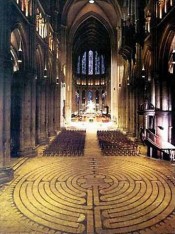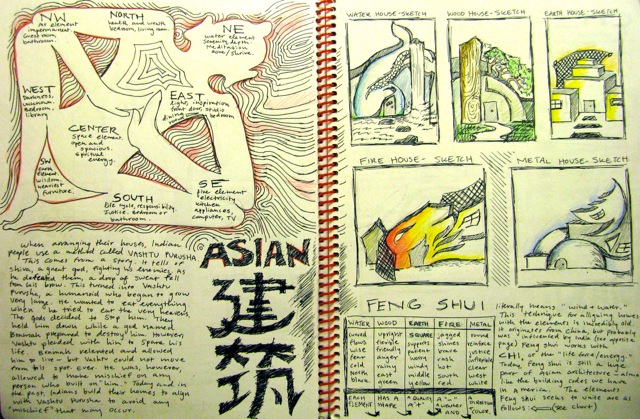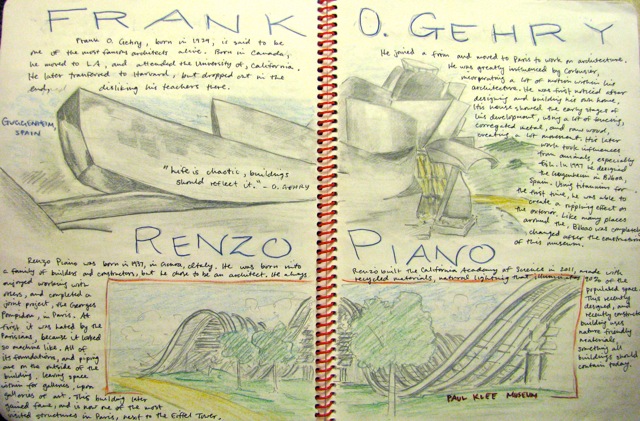Waldorf News
Architecture: The Mother of All Arts by Van James

Architecture is what we create between the given forms of nature and the structure of our own physical body. We put ourselves “into” our buildings and they affect our environment as they work back upon us. As Winston Churchill said during the rebuilding of London after the bombings of WWII, “We shape our buildings and our buildings shape us.”
The first main lesson block for Honolulu Waldorf School twelfth graders is the History of Architecture, a subject that explores the connections in the humanities (history, anthropology, archaeology, mythology and literature), mathematics, and the science of engineering, not to mention art and aesthetics. In this way it provides a solid foundation for starting this last year of high school, as it supports young adults in their own search for balancing inside and outside–inner life and outer reality, and provides a perfect keystone for centering many fields of study. By way of drawing, writing, hands-on projects, oral presentations, and discussion, students begin to see the built environment around them in an entirely new way. Field trips aid and deepen this process, for buildings are not just theoretical, they need to be experienced in three dimensions.




The Waldorf schools in New York, Chicago, San Francisco, Sydney, London, and Berlin, have the unique opportunity for seeing great architecture in their cities. The Honolulu Waldorf School students do as well! On a recent field trip to downtown Honolulu, the twelfth graders saw buildings of many different styles, utilizing various construction techniques and a wide range of building materials, and made sketches of Neo-Classic, Renaissance Revival, and Modern Symbolist architecture (see photos). The fact that Honolulu has the only royal palace in the United States (which had electric lights before the White House, in-door flush toilets, and inter-room phones well in advance of other cities) is worth noting, and that is what the seniors have done by creating their own History of Architecture notebooks during this course (see photos).
Rudolf Steiner, Ph. D., the founder of Waldorf education, was not trained as an architect, yet he designed and had built some twenty-four buildings during his lifetime, including the internationally acclaimed first and second Goetheanum buildings in Switzerland. His architecture has inspired the building of hundreds of Waldorf schools. He said that in the future buildings would have the power to “speak” to us. That they would influence us in such a way that they could even prevent crime and wrongdoing simply by way of their dynamic, expressive forms.
During an architecture block several years ago one student commented on the rhythmic changes in styles from constricted, geometric structures to flamboyantly fluctuating buildings. She said that because of this ever-alternating expansion and contraction in the styles of architecture (Egyptian to Greek, Romanesque to Gothic, Renaissance to Baroque, Neo-classic to Neo-gothic, International Style to Organic) it was like the “heartbeat of civilization.” She could sense something “alive” within the outer form of architecture. This student went on to study medicine.
Understanding the history of architecture can have far-reaching effects on the young person as they design their identity and build their future.
The main lesson book drawings were created by Yves Kline and Aloe Corry (class of 2012) at the Honolulu Waldorf School.
Van James is a teaching artist at the Honolulu Waldorf School and an art instructor at the Kula Makua–Waldorf Teacher Training program in Hawai’i. He is a guest lecturer at Rudolf Steiner College in California and Taruna College in New Zealand. He is the author of several books on culture and the arts, including “Spirit and Art” and “The Secret Language of Form.”



 Bay Area Teacher Training
Bay Area Teacher Training Flexible preparation for your new grade
Flexible preparation for your new grade Quality Education in the Heartland
Quality Education in the Heartland Waldorf-inspired Homeschool Curriculum
Waldorf-inspired Homeschool Curriculum Middle School Science With Roberto Trostli
Middle School Science With Roberto Trostli Immersive Academics and Arts
Immersive Academics and Arts ~ Ensoul Your World With Color ~
~ Ensoul Your World With Color ~ The Journey is Everything
The Journey is Everything Waldorf Training in Australia
Waldorf Training in Australia Apply Today: New Cohort Starts Nov. 2025
Apply Today: New Cohort Starts Nov. 2025 Space speaks. Its language is movement.
Space speaks. Its language is movement. Train to Teach in Seattle
Train to Teach in Seattle Jamie York Books, Resources, Workshops
Jamie York Books, Resources, Workshops Transforming Voices Worldwide
Transforming Voices Worldwide Summer Programs - Culminating Class Trips
Summer Programs - Culminating Class Trips Association for a Healing Education
Association for a Healing Education Bringing Love to Learning for a Lifetime
Bringing Love to Learning for a Lifetime Caring for All Stages of Life
Caring for All Stages of Life Roadmap to Literacy Books & Courses
Roadmap to Literacy Books & Courses
 Great books for Waldorf Teachers & Families
Great books for Waldorf Teachers & Families Everything a Teacher Needs
Everything a Teacher Needs Full-Time Teacher Education
Full-Time Teacher Education RSS Feeds
RSS Feeds